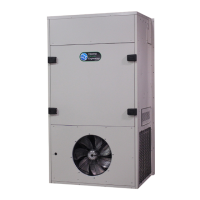23
ECU 04/2015 rev.3
PROBLEM/SYMPTOM LIKELY CAUSE(S) CORRECTION
B. Unit runs for long periods or continu-
ously; cooling is insufcient.
1. Dirty lter or reduced airow
2. Low refrigerant.
3. Component failure.
4. Unit undersized for job.
1. Check air lter(s). Check blower operation. Remove
airow restriction.
2. Check for proper charge and possible refrigerant leak.
3. Check internal components, especially compressor for
proper operation.
4. Add additional units for greater capacity.
C. Unit cycles on high/low pressure
limit.
1. Loss or restriction of airow.
2. Restriction in refrigerant circuit.
3. Refrigerant overcharge (following
eld service)
4. Defective pressure control.
1. Check blower assembly for proper operation. Look
for airow restrictions, e.g.. the air lter. Check blower
motor and condenser fan.
2. Check for blockage or restriction, especially lter drier
and capillary tube assembly.
3. Evacuate and recharge to factory specications.
4. Check limit cutout pressures. Control is set to actuate at
approximately 60 PSIG (low pressure) and 650 PSIG (high
pressure).
D. Unit blows fuses or trips circuit
breaker.
1. Inadequate circuit ampacity.
2. Short, loose, or improper connection
in eld wiring.
3. Internal short circuit. Loose or
improper connection(s) in unit.
4. Excessively high or low supply volt-
age or phase loss (3ø only).
1.
Note electrical requirements in Chapter 2 and correct
as necessary.
2. Check eld wiring for errors.
3. Check wiring in unit. See wiring and schematic dia-
grams. Test components (especially the compressor)
for shorts.
4. Note voltage range limitations specic to the com-
pressor troubleshooting section.
E. Water on oor near unit. 1. Obstruction in condensate line.
2. Obstruction or leak in condensate
pan.
3. Unit is not level.
1. Check for clog or restriction.
2. Check pan for leak or blockage.
3. Level unit.
F. No space heating or reduced heating
(units equipped with resistance ele-
ments)
1. Defective heating element(s).
2. Thermal limit open.
3. Defective heater contactor.
1. Check resistance element(s) for continuity.
2. Check continuity across thermal limit switch.
3. Check relay for proper operation. Replace if defective.

